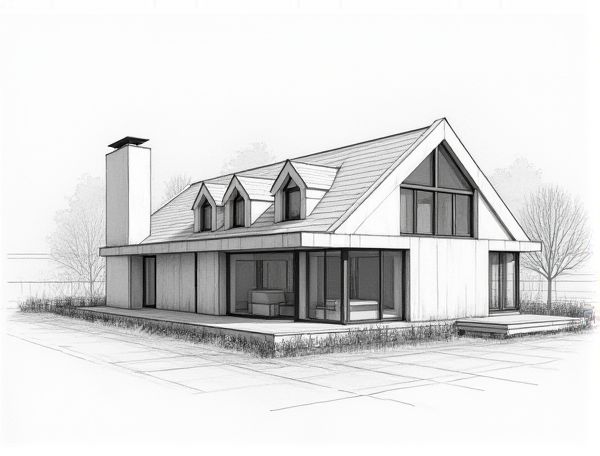
Photo illustration: Pasivhaus home design with triple-glazed tilt-and-turn windows
Pasivhaus home design prioritizes energy efficiency and comfort, with triple-glazed tilt-and-turn windows providing superior insulation and airtightness to minimize heat loss and enhance indoor air quality. Discover how incorporating these advanced windows can transform your home's sustainability and comfort by reading more in the article.
Introduction to Passive House Principles
Passive House principles emphasize airtight construction, high thermal insulation, and efficient ventilation systems to minimize energy consumption while maximizing indoor comfort. By integrating these strategies into Your home design, you achieve superior energy efficiency and sustainable living with reduced utility costs.
The Importance of High-Performance Windows in Pasivhaus Design
High-performance windows in Passivhaus design drastically reduce heat loss while maximizing natural light, enhancing energy efficiency and comfort in your home. These windows feature advanced glazing, airtight frames, and superior insulation, ensuring minimal thermal bridging and maintaining indoor temperature consistency. Investing in high-performance windows contributes significantly to meeting the rigorous Passivhaus standards, lowering energy bills and promoting sustainable living.
Understanding Triple-Glazed Tilt-and-Turn Windows
Triple-glazed tilt-and-turn windows enhance energy efficiency by incorporating three layers of insulated glass, significantly reducing heat loss and noise infiltration compared to double-glazed alternatives. Their dual-function design allows for secure ventilation through tilting while providing full inward opening for easy cleaning and emergency egress, making them ideal for modern, energy-conscious home designs.
Energy Efficiency Benefits of Triple-Glazed Windows
Triple-glazed windows enhance your home's energy efficiency by providing superior insulation, reducing heat loss by up to 50% compared to double-glazed options. These windows also minimize outside noise and help maintain consistent indoor temperatures, leading to lower heating and cooling costs throughout the year.
Thermal Insulation and Airtightness in Pasivhaus Homes
Thermal insulation in Passivhaus homes utilizes high-performance materials such as mineral wool and rigid foam to minimize heat loss, ensuring energy efficiency and comfort throughout the year. Airtightness is achieved through meticulous construction techniques and advanced sealing products that prevent unwanted air infiltration, helping you maintain consistent indoor temperatures and reduce heating costs.
Enhancing Indoor Comfort with Advanced Fenestration
Advanced fenestration systems improve indoor comfort by optimizing natural light, regulating temperature, and reducing glare through high-performance glazing and smart shading solutions. Your home benefits from enhanced energy efficiency and improved air quality, creating a healthier and more comfortable living environment year-round.
Window Orientation and Daylighting Strategies
Window orientation significantly influences natural daylight penetration, with south-facing windows maximizing solar gain in winter and north-facing windows providing consistent, diffused light year-round. Effective daylighting strategies integrate optimal window placement, appropriate glazing types, and shading devices to reduce glare and heat gain while enhancing indoor illumination and energy efficiency.
Achieving Noise Reduction with Triple-Glazing
Triple-glazing windows enhance noise reduction by utilizing three panes of glass separated by insulating air or gas layers, significantly minimizing external sound transmission. This advanced window technology is particularly effective in urban environments, offering homeowners a quieter and more comfortable living space.
Sustainability and Environmental Impact of Pasivhaus Windows
Pasivhaus windows significantly reduce energy consumption by optimizing thermal insulation and minimizing heat loss, which contributes to lower carbon footprints in residential buildings. These high-performance windows feature triple glazing, airtight seals, and thermally broken frames designed to enhance energy efficiency and indoor comfort. The use of sustainable materials in Pasivhaus windows further supports environmental responsibility by reducing resource depletion and promoting long-term durability.
Cost Considerations and Long-Term Savings
Investing in energy-efficient appliances and sustainable materials can significantly reduce your home's utility bills and maintenance costs over time. Strategic insulation and smart home technologies improve energy consumption, providing substantial long-term savings while increasing property value. Careful planning of initial expenses ensures your home design balances upfront costs with future financial benefits.
 homedesy.com
homedesy.com